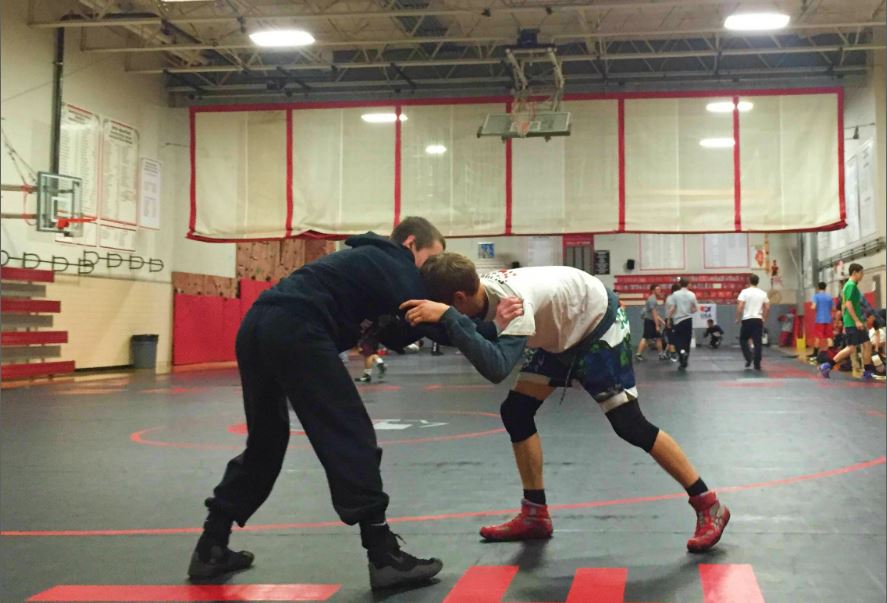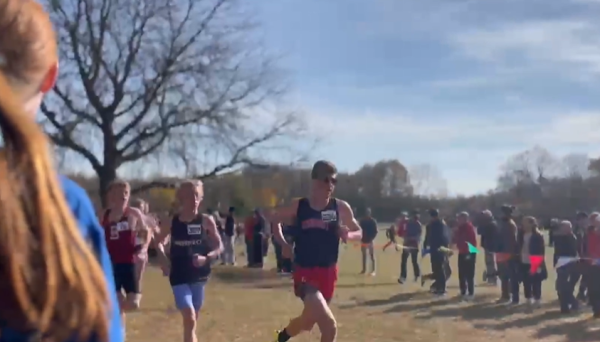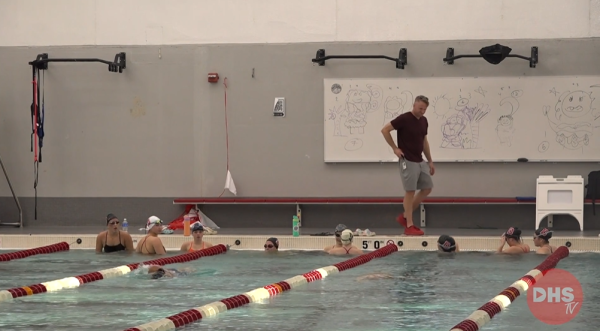How wrestlers cut weight without risking their health
Varsity wrestlers practice their moves to prepare for upcoming competitions
Pointing out a wrestler from crowd will only take you seconds. All you have to do is look for the person that is wearing multiple layers, drinking outrageous amounts of water, or chowing down on any food your mom forces you to eat.Training for any sport can be demanding and exhausting. It could force you to wake up at the break of dawn to get a quick workout in before school or spend long nights practicing for the upcoming meet. These practices may sound grueling to the average person, but for a wrestler, it’s a whole different story.
Wrestling has been deemed one of the hardest and most unique sports. This sport is set apart from others by their unique ways of training. One of the most controversial practices is cutting weight. The different weight classes force athletes to lose or gain drastic amounts of weight in a short period of time. An athlete may have to cut down on water intake or even spit into a cup to lose some pounds in a short period of time. Although it may sound ridiculous, this can be a normal training method that comes with strict safety guidelines in order for the wrestler to stay healthy and ready to perform.
A wrestler guzzling down a powdery protein shake isn’t having a snack, they are actually training for their incredibly demanding sport. The first impression of them may be how crazy they are for putting so much effort into losing weight for a sport. High school sports can make or break an athlete’s career, and after coming out on top season after season, their “extreme” diets seem to be successful and maybe even necessary. The next thought may be about how they stay safe throughout their incredibly difficult training regimen. Nick Kupets, a senior at DHS, has been wrestling since middle school. Throughout the past six years, cutting weight has been an important part of his training.
“At the beginning of the season you have a hydration test and they pinch your skin in a couple of places to get percent body fat. Then the state tells you what weight class you can wrestle at without it becoming dangerous. After that, the coaches put you on a diet plan that tells you what foods we should be eating to make it easier on us. You have to run, eat healthy, cut out carbs and sodium, and stay hydrated,” Kupets said.
The baby food diet, grapefruit diet or juice cleanses have come up as fad diets that do more harm than help. Depriving your body of nutrients it needs to survive can lead to extreme damage. The wrestlers’ diet, however, is the complete opposite of starving yourself for dangerous results. Throughout the years, stricter rules have been put in place to reduce the dangers of dieting. While it may be safer, the horror stories of extreme measures taken to cut weight still linger. Terrifying reports of athletes sitting in saunas in plastic suits, or refusing liquids while killing themselves exercising to lose extra pounds. These instances still resonate with the athletes, and encourage them to stay healthy.
“Some people cut a lot of weight and have to resort to unhealthy things, but coaches make sure that you are healthy and performing well. As long as you are performing well, they know that you are not starving or dehydrated. They definitely make sure you are doing it safe. Our coaches watch closely to see how you are doing,” Kupets said.
Imagine if you stood in front of all your peers while the trainers’ cold hands pinch at your fat, or having to stand onto a scale that determines your stance in the meet. After dieting for weeks, the expectation of sunken cheeks and wobbly legs disappears as you see the impeccable health the athletes are in. Coaches have dedicated time and effort into keeping their wrestlers in top shape. In the past wrestling, the rules were much looser, enabling the wrestlers to put themselves in danger. After wrestling from the age of nine until adulthood, Coach Pechter has seen many changes in the rules.
“Anyone with a body fat percentage of seven is not allowed to lose weight. It is also a personal choice. They are only allowed to lose 1.5% of their body fat per week. There are so many more rules in place. The most important thing is the safety of the athlete because we are doing this to win,” Pechter said.
It is never easy for the wrestlers to cut weight. Instead of joining their friends chowing down on chips and cookies, they are stuck eating a kale salad and a protein bar. But as the coach clearly stated, the wrestlers go through dieting and tough workouts to win, and it has been proven successful. The Deerfield team is currently ranked sixth in the state, but all people can think about are their extreme diets. Dylan Utterback is an example of how dieting can help more than harm. After starting wrestling at only 65 pounds, he has risen through the ranks and become a valuable member to the team. From middle school to high school, the difficult task of cutting weight never changed his passion for wrestling.
“I would prefer not to cut weight, but I think it is necessary, especially because everyone does it. The hardest part is all the temptations and keeping the strict diet, but I know in the end it is going to pay off,” Utterback said.
There aren’t many sports that are as demanding as wrestling. For football you may need to bulk up during your season, and running requires you to stay agile, but none of these sports infiltrate your everyday life as much as wrestling does. The controversy may come from studies showing that cutting weight leads to psychological effects, such as rage or self-esteem issues, or the obsessive nature that goes hand and hand with weight control. Although the extreme weight loss is more common in higher level wrestling, damage is still a possibility for high schoolers. Some the athletes may think that it gives them an edge, while the others prefer not to put themselves in danger. Overall, the main goal is to be able to compete, and when the urge to cut weight gets the best of them, their chances of performing are destroyed.
“I think that it kind of comes with the sport, and it is not justified. Kids might have cut weight the wrong way or bad things throughout the country have happened. There are all these different checks and balances in place. People may not know that it is a lot safer than it has been before. They may think it’s detrimental, but a lot of sports could benefit from cutting weight. You have to be in great shape to compete and win, which is what we are doing,” Mr. Pechter said.






